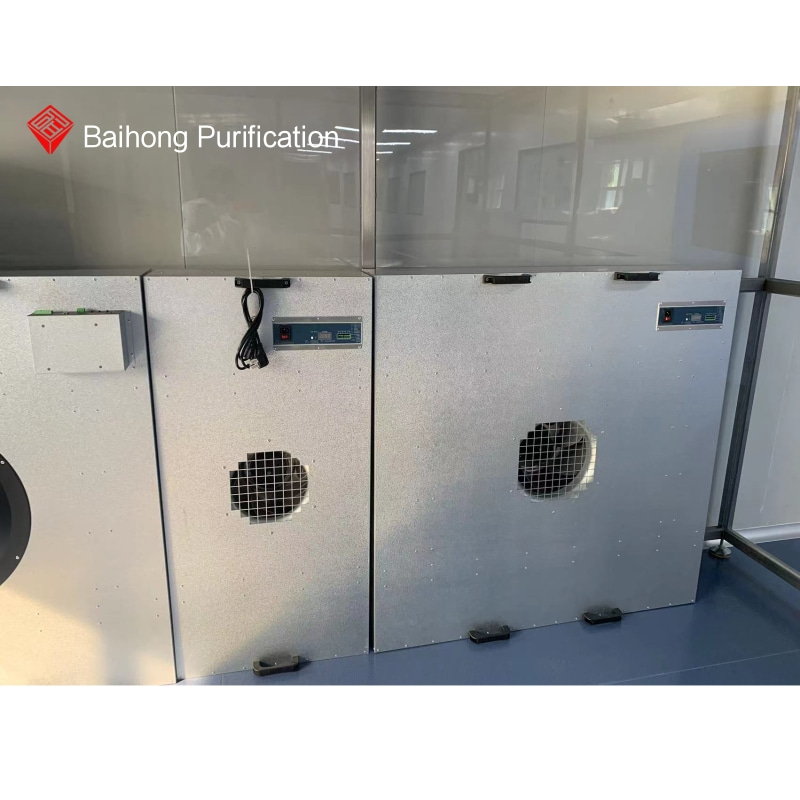Fan Filter Unit is a core equipment widely used in cleanroom environments. Its design not only contains advanced technology, but also requires exquisite manufacturing techniques, so it is deeply trusted and recognized by many users. Despite the excellent performance of Fan Filter Unit in the market, we still often receive inquiries from users: What is the difference between laminar flow hood and Fan Filter Unit? What type of Fan Filter Unit has more advantages?
In this article, Baihong Purification will briefly analyze “FFU vs laminar flow hood” for you.
The difference between Fan Filter Unit and laminar flow hood:
1. Laminar Flow Hood:
Application areas: Widely used in industries such as precision machinery, electronics, pharmaceuticals, food, and fine chemicals.
Function and positioning: Belonging to local purification equipment, the structure is relatively more complex than FFU. It has low requirements for overall environmental conditions and is mainly used to provide high cleanliness in specific areas (such as ISO 5/Class 100 or higher), making it particularly suitable for renovation projects or scenarios where only local high cleanliness requirements need to be met.
Flexibility of use: It can be used independently or in parallel over a large area to form a belt shaped clean area.
Structure and installation: It mainly consists of a box, a fan, a primary air filter, a flow damping layer, lighting fixtures, etc. The shell is usually treated with spray coating. The installation method is flexible, with the option to install on the ground with a bracket or hang it. Its design can be regarded as an advanced version of FFU, with more convenient filter replacement. It usually has a built-in flow plate to improve air uniformity and protect the filter, and its appearance is also more aesthetically pleasing.
Return air method: Usually, return air directly from the indoor environment where the equipment is located.
2.Fan Filter Unit:

Application field: It can provide high-quality clean air for cleanrooms and microenvironments of different sizes and cleanliness levels.
Function and advantages: FFU can effectively improve cleanliness, reduce noise and vibration, and significantly reduce overall cost in the construction of new cleanrooms or factory renovation/refurbishment. Its modular design makes installation and maintenance extremely convenient, making it an ideal component for building an ideal clean environment.
Typical application scenario: Mainly used for providing high-level clean environments over a large area (such as ISO 5/Class 100 or higher). Such applications typically require elevated floors and dedicated return air plenums, and lower levels of cleanliness must be maintained around the high-level area.
Core components: Essentially, it is an integrated unit of fans and high-efficiency filters.
Installation method: The standard installation method is suspended ceiling installation.
Return air method: Usually, air is returned through the space above the suspended ceiling.
Summarize key differences:
Structural complexity: The laminar flow hood structure is usually more complex than the basic FFU (with the addition of a box body, flow equalization plate, etc.).
Installation method: Laminar flow hoods are mostly installed on brackets (floor or suspended), while FFUs are mostly installed on suspended ceilings.
Return air path: laminar flow hood usually provides indoor return air, while FFU usually provides ceiling return air.
Flexibility/Upgradeability: Laminar flow hoods often have advantages in independent use, convenient filter replacement, and appearance.
Typical application scope: The application scope of FFU is usually wider than laminar flow hood, especially in the construction of large-scale high-grade clean rooms.
Although there are differences in structure and installation details between the two, such as the return air method, their core purification principles are the same – both achieve local or overall environmental purification by providing unidirectional flow (usually vertically downward) of clean air. The laminar flow hood can be regarded as an FFU derived device optimized for specific needs such as higher flexibility, convenient maintenance, and local high cleanliness.
Thank you for watching.
Baihong Purification is committed to providing you with professional clean air solutions!

